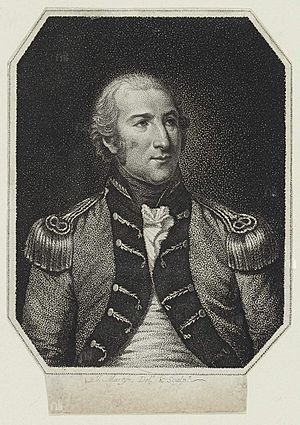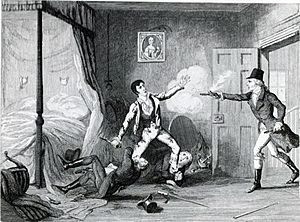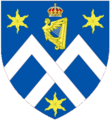Henry Charles Sirr (town major) facts for kids
Quick facts for kids
Henry Charles Sirr
|
|
|---|---|
 |
|
| Born | 25 November 1764 |
| Died | 7 January 1841 (aged 76) Dublin, Ireland
|
| Resting place | St. Werburgh's Church, Dublin |
| Occupation | Military officer, policeman, merchant |
| Known for | Killing of Lord Edward FitzGerald |
Henry Charles Sirr (born November 25, 1764 – died January 7, 1841) was an important figure in Irish history. He was an Anglo-Irish military officer, a policeman, and a merchant. He also enjoyed collecting art. Sirr is best known for his role in stopping the Irish Rebellion of 1798. This included his involvement in the arrest of Society of United Irishmen leader Lord Edward FitzGerald.
Contents
Early Life in Dublin
Henry Charles Sirr was born in Dublin Castle in Ireland. His father, Major Joseph Sirr, was the chief of police for Dublin from 1762 to 1767. Henry followed in his father's footsteps in a way.
He joined the British Army in 1778 and served until 1791. He returned to Dublin as a lieutenant. After his military service, he worked in the wine trade. In 1792, he married Eliza D'Arcy. They had two sons, Joseph D'Arcy Sirr and Henry Charles Sirr.
Becoming Dublin's Police Chief
In 1796, Henry Sirr joined the yeomanry in Dublin. This was a volunteer force that helped keep order. He quickly became the acting town-major, which meant he was the head of the police. From then on, he was known as a key agent for the government in Dublin Castle.
By 1798, he was officially promoted to town-major. He was given a home inside Dublin Castle. Sirr worked hard to stop the Society of United Irishmen. This group wanted Ireland to be an independent republic.
Before the rebellion started in May and June 1798, Sirr was involved in many arrests. He arrested Peter Finnerty, who edited the United Irishmen's newspaper. He also arrested important leaders like Thomas Russell and Lord Edward FitzGerald.
The Arrest of Lord Edward FitzGerald
Sirr became widely known after the capture of Lord Edward FitzGerald on May 19, 1798. The day before, Sirr and his soldiers tried to arrest FitzGerald but he escaped.
The next evening, Sirr got another tip and raided a house. FitzGerald, who was ill, tried to escape. He injured two officers, Captain William Bellingham Swan and Captain Daniel Frederick Ryan. When FitzGerald saw Major Sirr, he reportedly moved towards him. Sirr fired, hitting FitzGerald in the shoulder.
FitzGerald later died on June 4. An official investigation found that his death was caused by "water on the chest." This means fluid had built up in his lungs.
After FitzGerald's arrest, the United Irishmen felt pressure to start their rebellion. During this time, Sirr's life was often in danger. He reportedly escaped attempts on his life by United Irishmen three times in 1798.
Legal Challenges and Later Arrests
In 1802, Sirr faced a lawsuit called Hevey v. Sirr. This case showed how the Dublin police sometimes misused their power. A businessman named Mr. Hevey sued Sirr. Hevey had spoken out against a witness in a previous case Sirr was involved in. Because of this, Sirr and his colleague had arrested Hevey without good reason. Hevey was held without contact with others and his goods were taken.
The jury in the lawsuit found Sirr responsible for damages. He had to pay £150. The government paid Sirr's legal costs.
On August 25, 1803, Sirr helped arrest Robert Emmet. Emmet had led a failed uprising in Dublin the month before.
In 1808, Sirr became a police magistrate for Dublin. He continued his duties as town-major until 1826. He then retired with full pay. He was allowed to keep his official home in Dublin Castle because of his public service.
Later Life and Interests
Even after the Dublin police were reorganized in 1808, Sirr kept his title. He used his earnings and free time to collect art, interesting objects, and old artifacts. His collection of about 500 paintings was later given to the Royal Irish Academy.
In 1818, he helped start the Irish Society for Promoting Scriptural Education in the Irish Language. This group aimed to promote education in the Irish language.
Sirr died on January 7, 1841. He was buried in the graveyard of St. Werburgh's Church in Dublin. This was close to where Lord Edward FitzGerald was also buried in the same church.
Sirr had planned to destroy all his letters and papers. However, many important historical documents were found after his death. His son later gave these documents to Trinity College Library, Dublin.
Images for kids



